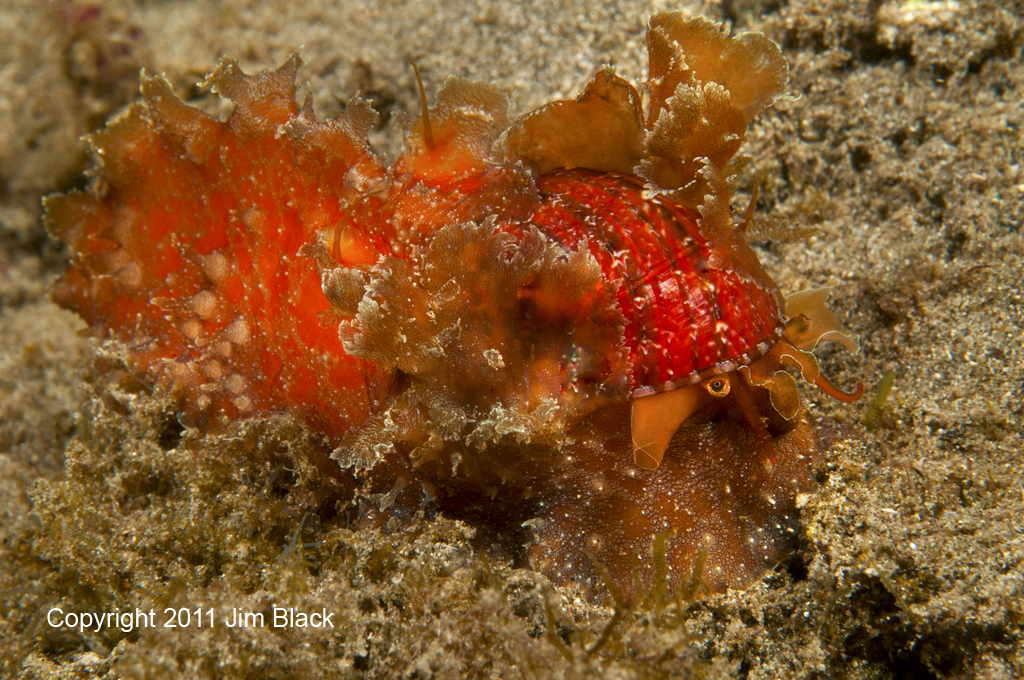 |
Tapestry Turban Shell
Image courtesy of Jim BlackAmbon, Indonesia
As far as can be determined this is the first published image of the Tapestry Turban Shell animal fully expanded in its natural habitat
Nikon D-300 in Subal Housing with Ikelite strobes
Copyright 2011, Jim Black
Tapestry Turban Shell
MARINE MYSTERIES
Sea Shells have been collected and traded as ornaments, or currency across the world for many centuries. These wonderful products of nature's architecture are the protective 'houses' of a large Phylum of aquatic and terrestrial creatures called Molluscs.
It was my interest in Sea Shells that originally inspired me to take up scuba diving to become an underwater explorer some 50 years ago. However, as a terrestrial naturalist it did not take me long to realise that in regard to the very animals that constructed the objects of my desire, there was very little natural history known.
I began a number of underwater studies in and around Sydney Harbour, New South Wales Australia keeping records of all observations, even tagging shells to establish how long it took some species to grow. I also gathered around 300 species of molluscs with egg capsules, so that these could be identified in the future, even if the adult shell was not in the vicinity.
My first nudibranchs were pencil drawn with arrows on the sketches relating to the colours.
Then in 1968 I had a perspex underwater housing built for an Edixa 35 mm focal plane camera with bulb flash. At the sight of my first reasonable nudibranch image, I realized that underwater imagery was the future to marine life identification and underwater natural history; my entire world took on a new meaning.
I began 'collecting' living animals on film and compiling the Australasian Marine Photographic Index visual identification system. I have since pursued my educational ideal over 14,000 dives, 100,000 images and 65 marine life identification guidebooks.
Since the inception of my Underwater Geographic Magazine that ran for 14 years, (but was put out of business some 22 years ago by the digital age and my lack of knowledge on the subject) I have had thousands of inquiries from beachcombers, reef walkers, snorkelers and scuba divers as to helping them out with the identities of strange marine creatures they have encountered.
Recently Mr. Jim Black who had been so kind as to lend me a number of his brilliant images for my NUDIBRANCHS ENCYCLOPEDIA published in 2008, sent me some images to identify.
The Tapestry Turban Shell
One was a strange 'mini monster' like being that defied all attempts to identify it.
One glance and I knew what it was, even though I had never ever seen a live specimen fully expanded. Absolutely brilliant images; Jim had solved the mystery of why the Tapestry Turban Shell had such a glossy, smooth shell when all the rest of its family were rough and mostly covered by marine growths.
A dead Tapestry Turban Shell on a reef at night
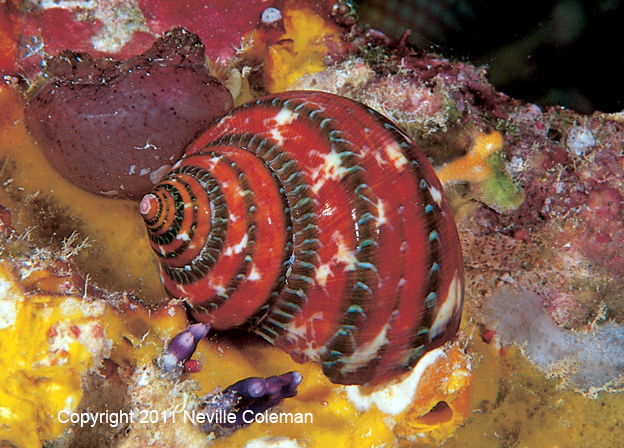 |
The Tapestry Turban Shell Turbo petholatus belongs to the family Turbinidae in which there are over two hundred mostly tropical species. All species are herbivores, living on coral and rocky reefs where they may be diurnal, or nocturnal and feed by scraping micro algae from the surface of rocks, or other algal growths. The Tapestry Turban Shell is strictly nocturnal and during the day hides away beneath dead coral slabs and under rocks where it often burrows into the smallest crevice, or hole. It grows to 6 cm and is common and widely known across the Indo-Pacific shallow water reefs. Its beautiful pattern and glossy shell make it a very popular tourist item and thousands are sold in shell shops and tourist shops throughout its range. |
The calcareous operculum of the Tapestry Turban Shell known as a Cat's Eye withdrawn to protect
the animal.
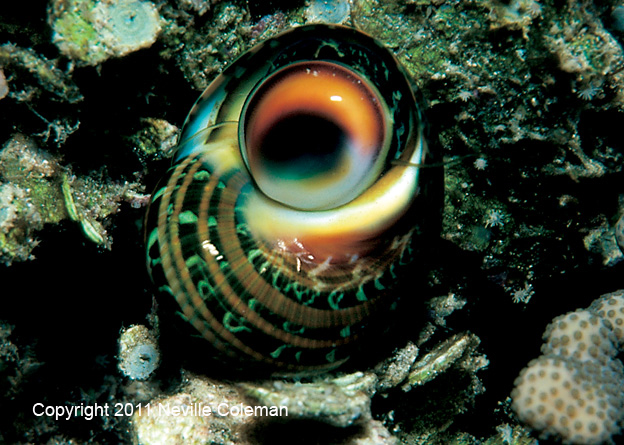 |
Jim asked as how the Tapestry Shell animal can squeeze all of its bulk back into the shell once it is expanded?
Like many molluscs (including nudibranchs) the animal actually expands its bulk by absorbing water into its body. When it is threatened, or retreats back into its shell, it just pumps the water out and deflates its bulk, allowing a retreat to be made into the safety of its shell.
Once most of the animal is withdrawn, it then plugs up the aperture with its calcareous operculum attached to the underside of the foot (known to beachcombers and shell collectors, as a Cat's Eye).
However, it is the strange lobed shape of the Tapestry Turban's mantle and foot that is so intriguing. Similar in some ways to the mantle of a Cowry Shell, the Tapestry Shells Mantle covers the entire Shell and keeps it glossy, protecting the Shell from being recognised by visual predators and from unwanted marine growths.
Until Jim's images arrived it its secret had been safe for many thousands of years; just one of the hundred thousand marine life secrets still awaiting discovery.
Springwood QLD, Australia Jan., 2012 Send Neville email at worldofwater@nevillecoleman.com.au
WEBMASTER'S NOTES : For the first time in The Slug Site's history, we have strayed from the normal venue of this site (Opistobranchs)to feature a shell! When Jim Black first sent this image to me, he was absolutely sure he was on to something very unusal but without a name tag, the story could go no further. Neville Coleman from down under was kind enough to fill in the missing pieces of the puzzle. I am sure after reading the story you will find that the shell "detour" was well worth the time! Once again Jim Black amazes us with his photographic skills and unending curiosity into Mother Nature's secrets. Kudos are definitely in order for Neville Coleman for writing the final chaper in this story! |
WEBMASTER'S NOTES (04/07/2012): Dr Richard Willan has advised that the featured ‘Shell of the Week’ posted on the Sea Slug site on January 9 is incorrectly identified as a juvenile Turbo petholatus (family Turbinidae). It is actually a species of Stomatella (Trochidae). The brown spiral bands suggest it is S. capieri Poppe, Tagaro & Dekker, 2006. Typical stomatelline features displayed by the animal of this specimen are its large size compared to its shell, the prominent wavy flange extending from the foot (epipodium) that is so extravagant in this species it resembles the mantle lobes of Lobiger, extremely large tail with prominent keel (this tail cannot be filled into the shell and can be cast off when the animal is threatened), prominent neck lobes (the right being rolled into an inhalant trough), and well developed flaps (cephalic lappets) between the head tentacles. There is no operculum.
Send Richard email at richard.willan@nt.gov.au
It has 1700 species and covers a range of 16 Marine Life Phyla.
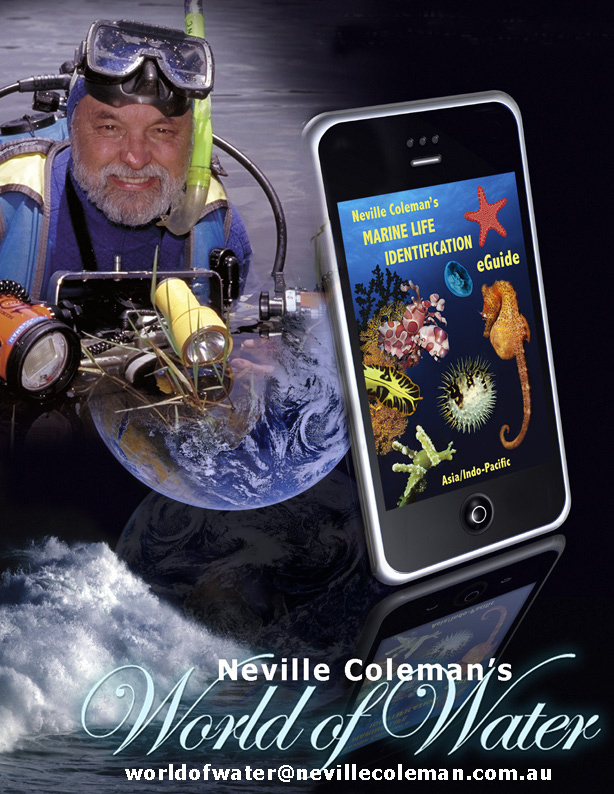
| |
His most recent publications are a series of 3 eBooks for iPads and iPhones, Dangerous Marine Life,
Venomous Marine Life and Poisonous Marine Life.
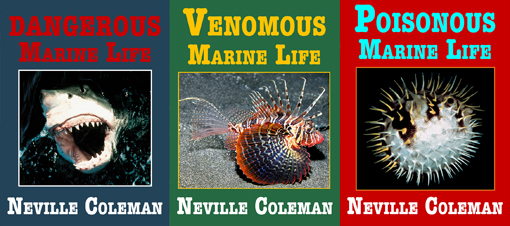
| |
All his Apps and eBooks are available at the Apple iTunes and Apple Bookstore and the Hazardous Marine Life
series allows FREE downloads trial downloads.
See www.nevillecoleman.com.au for all direct links.
Jim Black on location in in the Banda Sea
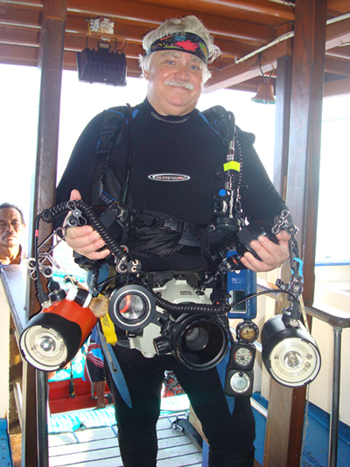 |
Jim is retired from US Airways after 27 years as a pilot..., flying Captain on an Airbus 330 Internationally. Diving since 1970...with over 6000 dives logged. Shoots Nikon D-300 in Subal Housing with Ikelite strobes. Macro Mate on 105mm for supermacro. Jim's photography has been featured in a number of books and publications including Helmut Debelius' Nudibranchs and Sea Snails of Gosliner, Behrens and Williams Coral Reef Animals of the Indo-Pacific. A photo of Jim petting a shark in "Sleeping Shark Caves" off Isla Mujeres Island, Mexico, taken by Amy Foster his significant other, recently appeared in Dave Behrens' Diving Guide to Cozumel, Cancun & The Riviera Maja.
Jim has been a solid supporter of the Slug Site since day one. His countless contributions put him near the top of the list of photographers who have greatly expanded our knowledge of sea slugs. There are a lot of kids in the formative stage of their education who are getting their first introduction to our sea slug friends via the great photographs Jim and other contributors have made to the site. My hat is off to Jim for making this presentation possible! Send Jim email at jim.black14@verizon.net WEBMASTER'S NOTES : Another great submission by Jim Black who continues to astound us with his uncanny ability to find and photograph slug/shell images most of us probably aren't going to see in this lifetime!
|
